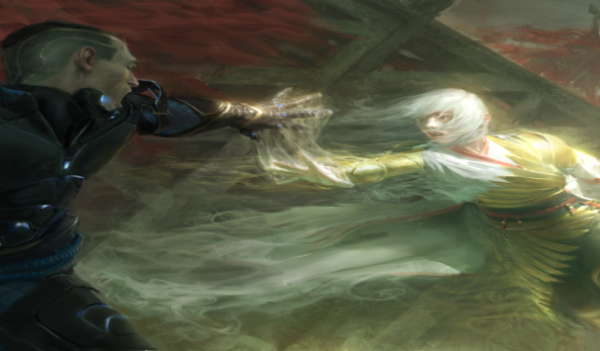Are you a Quiet Speculation member?
If not, now is a perfect time to join up! Our powerful tools, breaking-news analysis, and exclusive Discord channel will make sure you stay up to date and ahead of the curve.
While Phyrexia: All Will Be One (ONE) might not be history's most popular format, it's got depth and complexity, and over the last week, it has won me over. The rules of engagement are punishing if ignored, but once we learn them, it is extremely rewarding. After hammering the format last weekend, I easily waltzed into Mythic with a win percentage north of 67%. I don't make these claims to brag, but to clarify that this is a place where we can not only succeed, but dominate.
This is a downhill format. In ONE, we want to be on the board and pressuring our opponents. It's nice to have cards in our hand, but the battle is on the board, and that's where we want our resources. I've won plenty of games stranding a grip of cards in my opponent's hand. To win here, our curve should be low, and we should be looking to get the most out of our combat steps.
One Is the New Two
One of Limited's sacred truths is that two-drops are the most important part of your curve. While the twos are important in ONE, the ones might be even more vital. Playing a turn one Sawblade Scamp or Rustvine Cultivator in Oil, or a Bilious Skulldweller or Crawling Chorus in Toxic, puts us far ahead. These creatures jumpstart our gameplan and help us develop critical synergies early.
In the Toxic deck, we want to be attacking with mana open. If we can threaten Compleat Devotion as early as turn two, our opponent will rarely have good blocks.
Similarly, getting oil on the table fast accelerates the oil payoffs. A turn one Sawblade Scamp can get in easy damage before accruing oil counters, and can output a surprising amount of damage over the course of a short game. Rustvine Cultivator lets us get on board with an early blocker and helps to ramp while promoting oil synergies.
Porous Defenses
When we set up to block in this format, it feels like we're setting up to lose. The defensive role can often feel like our gameplan is scripted, so we want to make sure our curve is low enough that we're giving ourselves the early plays necessary to maneuver.
Even if we stabilize, we're not safe for long. This format has a number of ways to set up lethal.
Turn the corner or get stuck in one
Similar to Streets of New Capenna (SNC), it's hard to hold attackers at bay. So when we stabilize, we need to make sure we're pressuring our opponents fast. This format has a lot of reach, in the form of Sawblade Scamp and burn that goes to the face like Volt Charge and Urabrask's Anointer. Against Toxic, proliferate triggers can be lethal through any number of blockers. Haste creatures like Chimney Rabble and Furnace Strider, as well as cards that allow attackers to manipulate power every turn like the for Mirrodin! equipment Flensing Raptor and Porcelain Zealot, make it very hard to protect our life total.
The most devastating effect is Falter-Tremor hybrid Hazardous Blast. This card is playable in a lot of different red decks, and if the game starts aggressively, it does a really nice job of ending it on the spot.
This environment is one of the reasons why Cinderslash Ravager is so powerful. Vigilance is incredible in a format where a 1/1 toxic Mite can represent lethal, but we need to pressure opponents too. This card can come down quick, take out some small creatures on ETB, and play great offense and defense every turn.
Preferred Lanes: Base White and Base Red
The best two colors in the format are red and white, and it isn't particularly close. When we're drafting, we should be actively trying to find a home in one of these two colors. Red Oil decks and white Toxic decks are ideal, but these colors are strong even outside of those archetypes. They can both access artifact synergies with cards like Barbed Batterfist and Mandible Justiciar. And both offer high card quality at common, helping them be fine without any hyper-specific synergies.
White is the most aggressive color in the format and, ideally, one that capitalizes on toxic. That being said, the white aggressive decks are not limited to Wx Toxic. Cards like Mandible Justiciar, Bladed Ambassador, and Basilica Shepherd are dangerous threats in any brand of white deck. Dipping our toes in toxic let us enable corrupted payoffs, turning Incisor Glider and Zealot's Conviction into massive beatings.
Red is probably less powerful, but it's much easier to build. Almost any handful of red commons can be used in any color combination, making it a desirable place to start the draft. Red has great removal in Volt Charge and Hexgold Slash, solid two-drops, and excellent haste threats.
Right now, we should consider every other color to be a support color in the format. Which isn't to say they aren't good, but they don't hold a candle to red and white.
Green Is Good, but Missing Pieces
Green has some good commons and plays well with red and white. It offers great gold cards, but it's not deep enough, and more problematically, it's too slow to hang with the elite red and white.
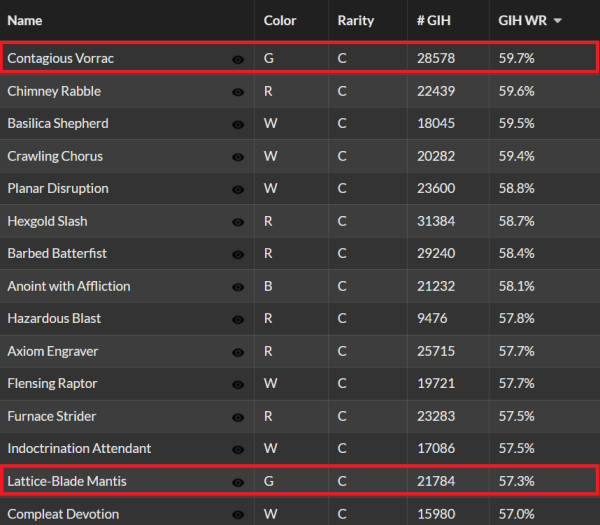
Green currently boasts the top common in the format, but it only has one other common with a GIH WR of over 57%. Comparatively, red and white have six each. This mirrors my experience drafting green. Cards like Rustvine Cultivator and Ruthless Predation are fine, but don't stack up to red and white's bevy of options.
At uncommon, green gets the duo of Cankerbloom and Evolving Adaptive. These two are not only excellent cards, but they provide much-needed support for the early game. Green has two obscene gold uncommons in Slaughter Singer and Cinderslash Ravager. Those cards are all good reasons to get into green, especially if paired with red or white. We shouldn't be excited with green outside of those color pairs.
The Problem with Blue and Black
It's a tough time to be a Dimir mage. With a lack of strong commons, and generally inflexible game plans, these colors are far less appealing than the representatives of the Naya shard.
Last week we talked about the shortage of potent two-drops in blue and black. Strictly from an identity standpoint, these colors pine for a slower, grindier format. While both colors can support other strategies, the ones they propose on their own are inherently flawed in a format so hostile to slower decks.
Even worse, these colors don't do a great job of turning the corner once we stabilize. Often times, these decks will get down to eight or nine life, begin to turn the corner, and inevitably lose to a Hazardous Blast.
It's frequently optimal to pass a superior blue or black card for a red or white one. There are certainly powerful rares and uncommons in this pair, but we should never be in these colors for their commons. Even Anoint with Affliction is something I no longer consider first-pickable. The decline in black commons is a huge warning sign, and while some of them may be intrinsically powerful, the card quality is generally low.

Drown in Ichor and Bilious Skulldweller are the only cards short of a rare I'd be satisfied taking pack one, pick one. Mainly because they play so well in BW Toxic, which is the only black deck I'm interested in. Even then, we should be cautious.
The blue commons are simply laughable.
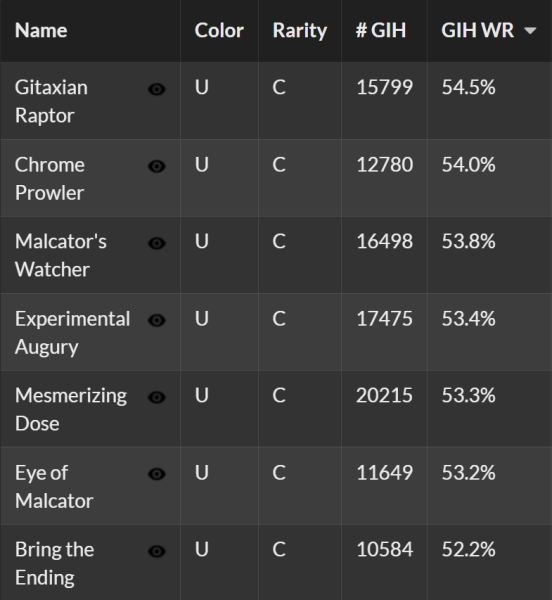
Yikes. The commons are so bad that even powerful uncommons like Unctus's Retrofitter and Tamiyo's Immobilizer perform at a mediocre rate.
Self-Correcting?
We can exploit some of these truths as they become ubiquitously accepted. Players will adjust, and the format will evolve. However, to paraphrase the Declaration of Independence, these truths are lookin' pretty self-evident. Red and white are great, we need to get on board early, and we desperately want to be the beat down. The cards that can create those game states, and the cards that can swing the tempo in our favor, should be the highest picks.
While blue and black are bottom-feeders, they still have powerful cards at higher rarities. A deck like this offers a potential glimpse into the future of the format. Once players start adjusting their pick orders to adapt to ONE's rules of engagement, the format should theoretically become less aggressive.
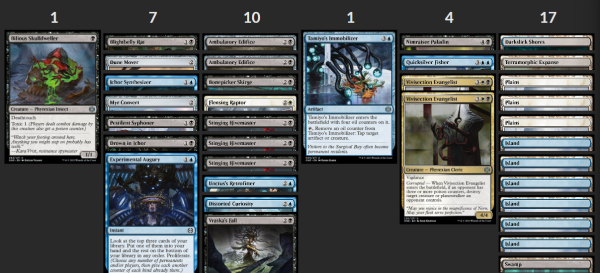
7-2 UBw Toxic Control
This deck is playing a mere three blue commons. It's the vision of a UB Toxic Control deck, but to come together needs the colors to be open and a high card quality within those colors to be opened at the table. While this is rightfully the road less travelled, we should keep an eye on these types of decks.
Revisiting Last Week's Two-Drop Tiers
Last week, we created a tiered list of two-drops. While a linear layout of card quality is rarely as valuable as it is consumable, the list sparked some conversation. As a result, I've submitted a revision.
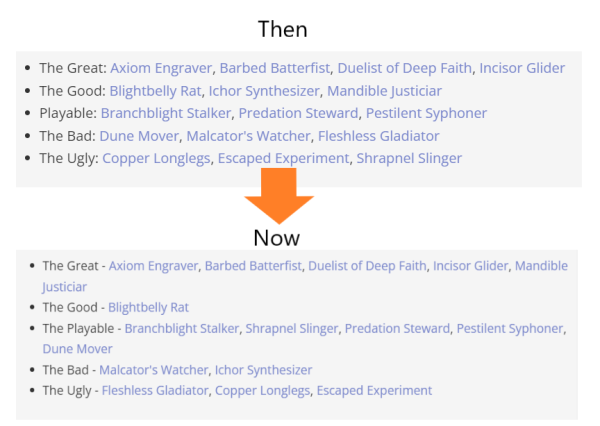
Mandible Justiciar is a valuable card for a number of reasons. It helps white decks race, which is essential to their strategy across all archetypes. This is especially true in Toxic and UW Artifacts, which are especially bad on defense.
The flexibility offered by Dune Mover and Shrapnel Slinger went undervalued in the initial list. Often these cards are, respectively, Goblin Piker and Grizzly Bears. The versatility is valuable, and the base rate of simply being a two-drop is something every deck needs.
Fleshless Gladiator has been terrible, and was downgraded as such. Ichor Synthesizer is still exciting, but struggles to deliver. While these cards might see more play as the format develops, they're currently bad. To be ready for the future, we need to understand the present, and come to grips with that reality.
None of the two-drops, however, are unplayable. Because the format demands early interaction, all of these cards can be used if needed. When we're selecting our two-drops, we want to ensure that we're developing our plan. Sometimes, in this format, that means trading off early to survive.
CABS in a Bucket
While the public disdain for the format is understandable, it is also short-sighted. The bombs are mostly kept in check by the aggression, and the aggression is something we can prepare for. By keeping our curve low, we give ourselves more options. By staying in proactive colors, we can control the tempo.
This is a CABS format, or one that greatly favors Cards (that) Affect the Board State. as such, we need to make sure we can play to the board. Losing a game with five cards in hand is still losing. When a card is in our hand, we can do one thing: play it. When a card is in play, our options multiply dramatically.
Often times CABS formats are written off as "basic" and abandoned. In my humble opinion, they're actually more skill-testing than slower, midrange formats. Constantly managing the race can be challenging, but that's the game.
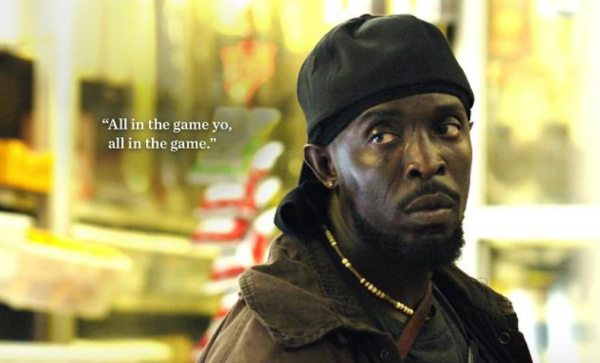
Make no mistake: ONE Draft is a complex format. For many of us, this will be a format that makes us better at the game. When we face difficult challenges, and we adapt, we learn. Losing can be frustrating, but hopefully studying the above rules of engagement will help. Next week, I'll be switching gears to focus on the Sealed side of this Limited environment. Wish me luck as I prepare for the upcoming Arena Qualifier, and look to adapting my understanding to a different environment.


